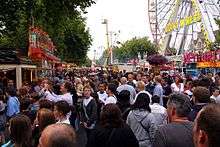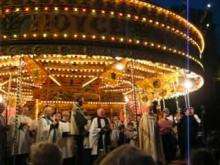St Giles' Fair


St Giles' Fair (also St Giles Fair) is an annual fair held in St Giles', a wide thoroughfare in central north Oxford, England.[1] It is unusual for an English fair, being held in a major street of a city and blocking traffic for its two-day duration in September each year.[2] The fair is organised by the Oxford City Council with the London and Home Counties section of the Showmen's Guild of Great Britain.[3]
The street is closed to traffic for two days each September for this traditional fair.[4] Formerly, the University Parks were also closed at the same time to demonstrate that they are owned by the University of Oxford rather than formally being public. The fair also extends into Magdalen Street to the south and Banbury Road and Woodstock Road to the north.
Since the 19th century, St Giles' Fair has been held on the Monday and Tuesday following the first Sunday after St Giles' Day (1 September). This means that when 1 September is a Saturday, the fair is held at the earliest possible time (3 & 4 September); but when 1 September is a Sunday, the fair is held at the latest possible time (9 & 10 September), as in 2013.
History
The origins of the fair related to St Giles' Church at the north end of St Giles'.[5] This was originally completed in 1120, but the church was not actually consecrated until 1200, by St Hugh of Lincoln, a Carthusian monk and bishop. As part of the commemoration of the consecration, St Giles' Fair was established. The fair continues to this day, nowadays as a funfair, held on the Monday and Tuesday after the Sunday following 1 September, which is St Giles' Day.[6]
The medieval fair was held in Walton Manor, where it took place in the St Giles' churchyard on St Giles Day and during the following week.[3] Queen Elizabeth I stayed in Oxford between 3–10 September 1567 and watched the fair from the windows of St John's College on the east side of St Giles'.
Traditionally, anyone with a beershop was allowed to bring barrels of beer to St Giles' Fair for sale.[7] Another custom was that any householder in St Giles itself could sell beer and spirits during the fair by hanging the bough of a tree over their front door.
The fair evolved from the St Giles' parish wake, first recorded in 1624, and which became known as St Giles' Feast.[2] In the 1780s, it was a toy fair, with cheap items for sale. By 1800, it had become a more general fair with stalls and rides. From the 1830s, the fair included adult amusements and it became more rowdy, so much so that there were calls for it to be closed. By the Victorian era, with train travel excursions becoming available, the fair was attracting people from places as far away as Birmingham and Cardiff.
In 1930, Oxford's city corporation, now the Oxford City Council, took over the running of the fair. During the 1930s, the poet John Betjeman described the fair as follows:
It is about the biggest fair in England. The whole of St Giles' and even Magdalen Street by Elliston and Cavell's right up to and beyond the War Memorial, at the meeting of the Woodstock and Banbury roads, is thick with freak shows, roundabouts, cake-walks, the whip, and the witching waves.[2]
References
- ↑ St. Giles' fair, The Oxford Guide.
- 1 2 3 Alison Petch, Calendar related artefacts: St Giles Fair, England: The Other Within, Pitt Rivers Museum, Oxford, UK.
- 1 2 Oxford St. Giles, National Fairground Archive, The University of Sheffield, UK.
- ↑ St Giles' Fair, Oxford History.
- ↑ Leslie Wood, St Giles' Oxford: Yesterday and Today — The Story of the Parish of St Giles', June 1974.
- ↑ St Giles' Fair, St Giles' Church.
- ↑ The Story of St. Giles and the Show, National Fairground Archive, The University of Sheffield, UK.
External links
Coordinates: 51°45′29″N 1°15′36″W / 51.7580°N 1.2601°W